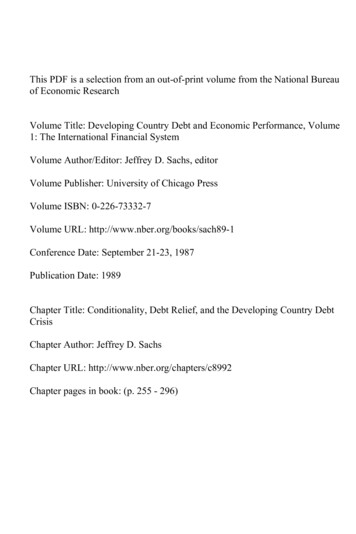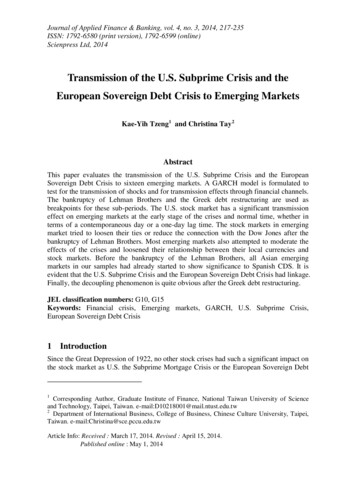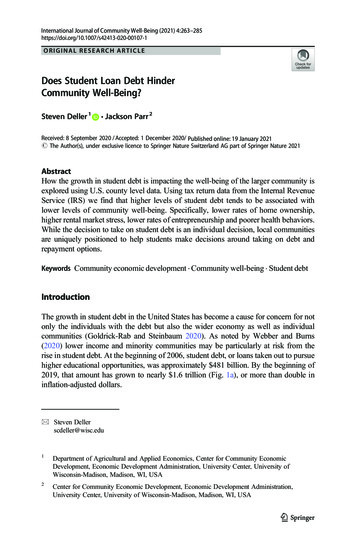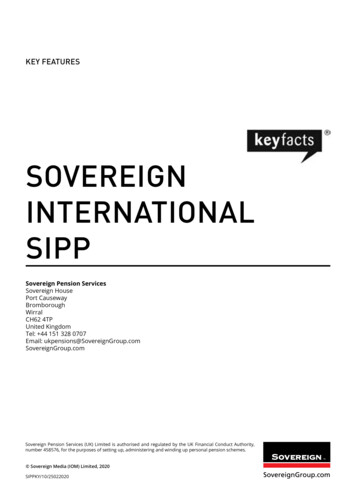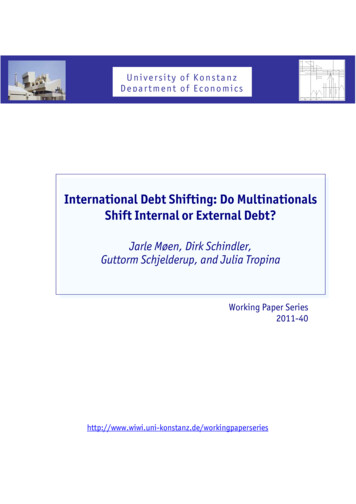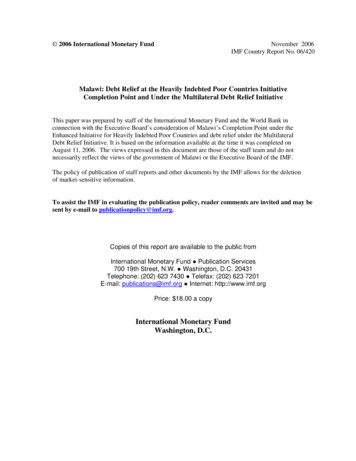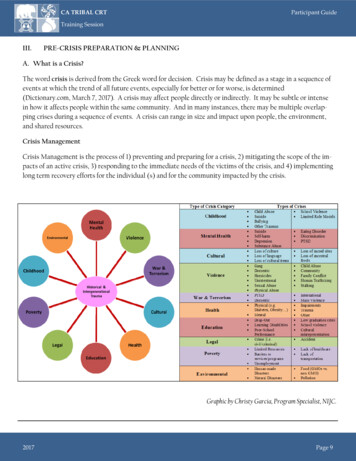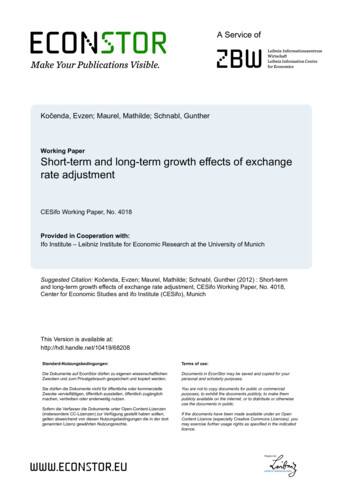
Transcription
Kočenda, Evzen; Maurel, Mathilde; Schnabl, GuntherWorking PaperShort-term and long-term growth effects of exchangerate adjustmentCESifo Working Paper, No. 4018Provided in Cooperation with:Ifo Institute – Leibniz Institute for Economic Research at the University of MunichSuggested Citation: Kočenda, Evzen; Maurel, Mathilde; Schnabl, Gunther (2012) : Short-termand long-term growth effects of exchange rate adjustment, CESifo Working Paper, No. 4018,Center for Economic Studies and ifo Institute (CESifo), MunichThis Version is available ngsbedingungen:Terms of use:Die Dokumente auf EconStor dürfen zu eigenen wissenschaftlichenZwecken und zum Privatgebrauch gespeichert und kopiert werden.Documents in EconStor may be saved and copied for yourpersonal and scholarly purposes.Sie dürfen die Dokumente nicht für öffentliche oder kommerzielleZwecke vervielfältigen, öffentlich ausstellen, öffentlich zugänglichmachen, vertreiben oder anderweitig nutzen.You are not to copy documents for public or commercialpurposes, to exhibit the documents publicly, to make thempublicly available on the internet, or to distribute or otherwiseuse the documents in public.Sofern die Verfasser die Dokumente unter Open-Content-Lizenzen(insbesondere CC-Lizenzen) zur Verfügung gestellt haben sollten,gelten abweichend von diesen Nutzungsbedingungen die in der dortgenannten Lizenz gewährten Nutzungsrechte.If the documents have been made available under an OpenContent Licence (especially Creative Commons Licences), youmay exercise further usage rights as specified in the indicatedlicence.
Short-Term and Long-Term Growth Effectsof Exchange Rate AdjustmentEvzen KočendaMathilde MaurelGunther SchnablCESIFO WORKING PAPER NO. 4018CATEGORY 7: MONETARY POLICY AND INTERNATIONAL FINANCEDECEMBER 2012An electronic version of the paper may be downloaded from the SSRN website:www.SSRN.com from the RePEc website:www.RePEc.org from the CESifo website:www.CESifo-group.org/wpTT
CESifo Working Paper No. 4018Short-Term and Long-Term Growth Effectsof Exchange Rate AdjustmentAbstractThe European sovereign debt crisis revived the discussion concerning the pros and cons ofexchange rate adjustment in the face of asymmetric shocks. Exit from the euro area is toregain rapidly international competitiveness. Exchange rate stability with structural reformscould be beneficial for long-run growth. We augment the literature by analyzing short- andlong-term growth effects of exchange rate flexibility in a panel-cointegration framework.Countries with a high degree of exchange rate stability exhibit lower short-term and higherlong-term growth. The degree of business cycle synchronization with the anchor countrymatters for the impact of exchange rate flexibility on growth.JEL-Code: C540, E320, E420, F320, F330, N200.Keywords: exchange rate adjustment, sterilization, European sovereign debt crisis.Evzen KočendaCharles University and Academy ofSciencesPolitických vězňů 7Czech Republic - 11121 Pragueevzen.kocenda@cerge-ei.czMathilde MaurelCentre d'économie de la SorbonneBoulevard de l’Hopital 106-112France - 75647 Parismathilde.maurel@univ-paris1.frGunther SchnablUniversity of LeipzigGrimmaische Straße 12Germany - 04109 Leipzigschnabl@wifa.uni-leipzig.deVersion: 22 November 2012
1. IntroductionThe recent wave of financial, balance of payments and sovereign debt crises has revived thediscussion about the appropriate adjustment strategy in the face of asymmetric shocks. Inmost crisis events such as the 1997/1998 Asian crisis, the 1998 Japanese financial crisis, the1998 Russian flu, the 2001 collapse of the Argentine currency board and even the USsubprime market crisis, the crisis countries embarked on monetary expansion and depreciationas crisis solution strategies. In contrast, originating in growing intra-European current accountimbalances (Arghyrou and Chortareas, 2008), during the most recent European sovereign debtcrisis a set of European crisis countries opted for staying in the Economic and MonetaryUnion (EMU; the EMU crisis countries) or maintaining tight exchange rate pegs to the euro(the Baltic countries and Bulgaria). The consequence was a strong pressure to curtailgovernment expenditure and to cut wages.The different adjustment strategies in the face of crisis based on inflation or deflation areembedded into different theoretical frameworks. Keynes (1936) and Mundell (1961) favouredmonetary expansion and depreciation to provide a quick fix for missing internationalcompetitiveness and high unemployment. In contrast, Schumpeter (1911) and Hayek (1937)stressed the role of wage and price cuts to boost long-term growth via an increasing marginalefficiency of private investment. In the context of the choice of the exchange rate regime,based on Friedman (1953), Mundell (1961) modelled the benefits of exchange rate adjustmentin the face of asymmetric shocks to stimulate (short-term) growth (Tavlas, 2009). In contrast,McKinnon (1963) highlighted the role of fixed exchange rates for macroeconomicstabilization and therefore as a tool for preserving the (long-term) growth performance.Empirical studies on the impact of the exchange rate regime on growth have come tomixed results. For instance, Levy-Yeyati and Sturzenegger (2002) who examine the impact ofthe exchange rate regime on growth for a sample of 183 countries in the post-Bretton-Woods0
era (1974-2000) based on a pooled regression framework find a negative impact of exchangerate stability on growth for emerging market economies. In contrast, Maurel and Schnabl’s(2012) static and dynamic panel estimations find a positive impact of exchange rate stabilityon growth for a set of 60 mostly emerging market economies.We aim to augment this literature by isolating the long-term and short-term growth effectsof exchange rate stability / flexibility based on a cointegration framework. This researchallows us to reconcile Mundell’s (1961) and McKinnon’s (1963) view on the impact ofexchange rate flexibility / stability on growth in the face of asymmetric shocks.2. Short- and Long-Term Growth Effects of (Non-) Exchange Rate AdjustmentFrom 2008 to 2012 the European debt crisis revealed the different adjustment strategies toasymmetric shocks and crisis. When many European periphery countries were hit by burstingbubbles, the reversal of capital inflows and (near to) unsustainable debt levels, the EMUmembership barred the way towards depreciation as a quick fix for the adjustment of unitlabour costs to regain international competitiveness.The loss of independent monetary policy and the exchange rate as adjustment tools toasymmetric shocks made price and wage adjustments necessary, which amplified the crisisand triggered different policy responses. Whereas Ireland (like the Baltic countries andBulgaria) embarked on doughty adjustment measures in the private and public sector, inGreece political resistance retarded reforms. The delayed reforms in Greece were reflected insubstantial rescue packages and rising imbalances in the ECB’s TARGET2 mechanism,which both provided a substitute for pre-crisis private capital inflows as financing mechanismfor persistent current account deficits.The issue of the appropriate adjustment mechanism for unsustainable current accountdeficits within the EMU is reminiscent of a discussion during world economic crisis in the1
1930s. Whereas Keynes (1936) called for monetary expansion and depreciation to provide ashort-term growth impulse, Hayek (1937) - in the spirit of Schumpeter (1911) - stressed theneed of price and wage adjustment. The controversy between Keynes (1936) and Hayek(1937) reflected different attitudes concerning the role of the government for macroeconomicstabilization. Whereas Keynes (1936) stressed the need for a timely anti-cyclical publicmacroeconomic impulse, Hayek (1937) believed in the self-healing forces of the market.The real exchange rate adjustment, which is required to rebalance the current accountposition of crisis countries, is framed by the theory of optimum currency areas. Building uponFriedman’s (1953) advocacy of flexible exchange rates, Mundell (1961) assumed thatcountries with a high probability of asymmetric shocks better preserve the exchange rate as anadjustment mechanism to stabilize growth, if labour markets are rigid. This reflects theKeynesian assumption of (short-term) price and wage rigidity and the crucial role of thegovernment for macroeconomic stabilization. In contrast, McKinnon (1963) argued that insmall and open economies a fixed exchange rate serves as a macroeconomic stabilizer byabsorbing nominal shocks to promote growth. To maintain a fixed exchange rate, sufficientprice and wage flexibility is necessary, which is line with Hayek’s (1937) and Schumpeter’s(1911) notion that declining prices and wages are the prerequisite for a robust recovery aftercrisis. 11Although the Keynesian notion of discretionary policy making is matched here with theneed for exchange rate flexibility and Hayek’s belief in price and wage adjustment as crisissolution strategy is linked to exchange rate stability, this does not exclude that both authorsmade different policy propositions concerning the choice of exchange rate regime. Keynes’(1980) Bancor was equivalent to a fixed exchange rate regime, whereas Hayek’s (1937)denationalization of money implies a flexible exchange rate regime. In detail Hayek (1937)embraced fixed exchange rates for a gold standard, but not for a fiat money-based2
The growth effects of the crisis adjustment strategies based on exchange rate or wageadjustment have a goods market and a capital market perspective. Keynes (1936) stressed theshort-term dimension with a focus on goods markets. In his view depreciation in the case ofcrisis helps to “jumpstart” the economy as real depreciation restores instantaneously theinternational competiveness. Real wages decline without cumbersome wage negotiations asinflation increases.Hawtrey (1919), who dedicated his academic work to the deflationary consequences of thereturn to the gold standard, pioneered the financial market based arguments in favour amonetary expansion during crisis. He assumed that low-cost credit during crisis helps toprevent a credit crunch (which is triggered by increasing risk perception in the privatebanking sector) and a dismantling of investment projects. New investment is encouragedwhich speeding up the recovery. As a fundamental restructuring process in the economy iscircumvented, dire wage cuts become dispensable, and this helps to maintain economicactivity via the consumption channel.In contrast, Hayek (1937) and Schumpeter (1911) help to understand the negative longterm growth effects of crisis therapy via monetary expansion and depreciation as restructuringis postponed. In Schumpeter’s (1911: 350) real overinvestment theory the recession is aprocess of uncertainty and disorder, which forces a reallocation of resources on the enterprisesector (“cleansing effect”). The reallocation is a pre-requisite for long-term growth asspeculative investment is abandoned, inefficient enterprises leave the market, the efficiency ofthe remaining enterprises is strengthened and new enterprises, products and productioninternational monetary system. As Kindleberger (1985: 1) puts it the “dichotomy is notbetween any particular views of those great economists. It is rather more general, betweenone school worried about inflation and deflation of prices and the quantity of money, and theother about output and employment.3
processes emerge. Exchange rate depreciation during crisis is an impediment to long-termgrowth as the “unadapted and unlivable” persists (Schumpeter 1911: 367). 2 In this context theexchange rate regime matters, as a fixed exchange rate (or membership in a monetary union)imposes the need for structural reforms.The monetary overinvestment theory of Hayek (1937) allows approaching the long-termgrowth effects of monetary expansion and depreciation from a capital market perspective.During the upswing low interest rates set by the central bank encourage investment withdeclining marginal efficiency. When rising inflation urges the central bank to lift interest ratesagain, investment projects with low marginal return have to be dismantled. The resultingcleansing effect is the prerequisite for a sustained recovery, as only dynamic investmentpersists. If, however, the central bank responds to the crisis by decisive interest rate cuts,investment projects with low marginal returns, i.e. a distorted production structure, areconserved. A structurally declining interest rate level deprives the interest rate of its allocationfunction (which separates high-return investment from low-return investment) thereby puttinga drag on long-term growth (Schnabl, 2009).Furthermore, as stressed by Mundell (1961) the question of if the exchange rate regimehas a positive or negative effect on the growth performance of countries – within anasymmetric world monetary system – hinges on the degree of business cycle synchronizationwith the anchor country. Because of underdeveloped goods and capital markets small andopen economies have an inherent incentive to stabilize the exchange rate versus the currencyof a large anchor country -- usually the dollar or the euro (Calvo and Reinhart, 2002). Ifbusiness cycles are synchronized with the anchor country, the monetary policy of the anchor2Schumpeter’s (1911) argument, which has been designed for the private enterprise sector,can be applied for the government sector as well. A strong recession will trigger onlystructural reforms if there are restrictions on fiscal and monetary expansion in place.4
country will be in line with the macroeconomic needs of the small open economy. If, however,business cycles are idiosyncratic, there is a larger need to stabilize growth via exchange rateadjustment. The recent contributions of the exchange rate regime literature in the wake of thefinancial crisis are reviewed by Beckman et al., (2012).Previous papers have tested for the overall average growth effects of exchange rateflexibility, partially contingent on business cycle synchronization. We augment this literatureby separating between the long-term and short-term growth effects of exchange rate flexibilitybased on a sample of 60 small open emerging market economies with the help of an errorcorrection framework.3. Data, Flexibility Measures and Business Cycle CorrelationTo trace the short-term and long-term impact of exchange rate flexibility on growth, wechoose five country groups for which the choice of the appropriate exchange rate regime hasbeen high on the political agenda. These country groups are the EU15, Emerging Europe, EastAsia, South America and the Commonwealth of Independent States (CIS). In the EU15 aswell as in Central, Eastern and Southeastern Europe (Emerging Europe) the discussion aboutmembership in the EMU and/or the optimum degree of exchange rate stability against theeuro continues to be discussed controversially. 3 The discussion about the pro and cons ofEMU membership was revived during the most recent crisis.In East Asia and South America the optimum degree of exchange rate stability againstthe dollar continues to be discussed, in particular since the Asian crisis and drastic US interestrate cuts following the subprime crisis. Most recently, Japan, China and Brazil have been3Kočenda and Poghosyan (2009) show that new EU members should promote nominal andreal convergence with the core EU members since both real and nominal factors impact thevariability of their exchange rate risk.5
involved in a discussion on “currency wars” and competitive interest rate cuts. In theCommonwealth of Independent States, Russia’s move towards a currency basket and thedepreciation of the CIS currencies during the recent crisis have revived the question about theoptimum exchange rate policy. In this context, the choice of the anchor currency and thedegree of business cycle synchronization with the anchor country play an important role.The five country groups include all countries of the respective region excludingmicrostates – which may bias the sample towards a very high positive effect of exchange ratestability on growth (Frenkel and Rose, 2002) – and excluding countries with insufficient data.This brings us to a sample size of 60 countries. Table 1 provides an overview of all countriesunder research, grouped into regions. We also list the prevalent anchor currencies and therebythe reference countries for measuring business cycle correlation. For the countries in EastAsia, South America and the CIS the dollar has been the prevailing target of exchange ratestabilization. Business cycle correlation is measured versus the US.For the European countries before the introduction of the euro in 1999, the German markhas been the dominant anchor currency (Gros and Thygesen, 1999). Since then, the euro hasbecome the natural anchor for the European non-EMU countries. Exchange rate flexibility ismeasured in terms of exchange rate fluctuations against the German mark before 1999 andagainst the euro after 1999. Once a country has entered the EMU the proxy for exchange rateflexibility is set to zero. Business cycle correlation in Europe is measured versus Germany,which is the largest European economy (and therefore a country with a high degree ofbusiness cycle correlation with the euro area). For Germany, France as the second largestEuropean economy is used as a reference country to measure business cycle correlation.6
Table 1 Country Groups, Anchor Currency, and Reference CountryCountryAnchor currencyCountriesgroupReference countryEU15Euro/DMAustria, Belgium, Denmark, Finland, France,GermanyGermany*, Greece, Ireland, Italy, Luxemburg,Netherlands, Portugal, Spain, Sweden, UKEmergingEuro/DMAlbania, Bosnia-Herzegovina, Bulgaria, Croatia,EuropeGermanyCzech Republic, Estonia, Hungary, Macedonia,Latvia, Lithuania, Poland, Romania, Serbia,Slovak Republic, Slovenia, TurkeyCISDollarArmenia, Azerbaijan, Belarus, Georgia,USKazakhstan, Kyrgyz Republic,Moldova, Russia, UkraineEast AsiaDollarChina, Hong Kong, Indonesia, Japan,USMalaysia, Philippines, Singapore,South Korea, Taiwan, ThailandLatinDollarArgentina, Bolivia, Brazil, Chile,AmericaUSColumbia, Ecuador, Paraguay,Peru, Uruguay, VenezuelaNote: France, as the second largest country of the European Union, is used as a reference country for Germany.The data source is the International Financial Statistics. Missing or inconsistent data werecompleted and cross-checked with national statistics, mainly by national central banks. Seriesused in estimations are at quarterly frequencies and are seasonally adjusted. Quarterly realGDP growth rates and inflation rates are calculated as year-over-year quarterly growth ratesto filter out the seasonal pattern and lower the volatility of the transformed series (𝑥𝑖𝑡 ln 𝑋𝑖𝑡 ln 𝑋𝑖𝑡 4). The sample period starts in January 1994 for two reasons. First, to excludethe beginning of the 1990s, which for most of the Central, Eastern and Southeastern Europeanand CIS countries implied high economic volatility and data uncertainty linked to thetransition process. Second, to have a balanced sample the observations for all other countriesstart in 1994 as well. The time series end in 2010. We compute quarterly measures for tradeintegration as exports plus imports over GDP. Finally, we include the interest rate of thepotential exchange rate anchor country as indicated in Table 1 as a proxy for externalmonetary conditions, which have been an important determinant of growth in emergingmarket economies (Maurel and Schnabl, 2012).7
We use de facto exchange rate flexibility measures, because de jure flexibility measuresare likely to be flawed by fear of floating. 4 Quarterly de facto exchange rate flexibility ismeasured by the standard deviation of monthly percent exchange rate changes of therespective quarter (σ) and the quarterly arithmetic average of monthly percent exchange ratechanges (μ). Both measures are summarized by the z-score (𝑧 𝜎 2 𝜇 2 ) as in Schnabl(2009) and Maurel and Schnabl (2012). All three variables are calculated against the euro orthe dollar, depending of the respective anchor currency as listed in Table 1.Finally, as we aim to analyze the impact of exchange rate flexibility on growth contingenton business cycles synchronization we construct a dummy for business cycle synchronization(Dbcc) for every country based on the five country groups defined earlier. If business cyclecorrelation of specific countries with the reference country is lower than the country groupaverage the dummy is set equal to one. The dummy is zero if the degree of business cyclecorrelation is above average.4. Empirical AnalysisGiven the different time dimensions of economic theories concerning the impact of exchangerate flexibility/stability on growth, the issue is an empirical one. The foregoing empiricalanalysis aims to disentangle the long-term and short-term effect of exchange rate flexibilityon growth, which may, possibly, reconcile both strands of the literature as presented insection 2 by attributing a time dimension to them. Our model below is not derived from a4Calvo and Reinhart (2002) show that the official (de jure) classifications of the exchangerate regime by the IMF are not necessarily in line with the practiced (de facto) exchange ratestrategies of countries. Therefore, following De Grauwe and Schnabl (2008) we assume thatexchange rate volatility is high in case of full exchange rate flexibility. This implies that lowexchange rate volatility indicates exchange rate stabilization efforts by central banks.8
standard neo-classical analysis of growth. Rather, by relying upon Schnabl (2009) or Maureland Schnabl (2012) it principally correlates quarterly growth rates and exchange rateflexibility.4.1. Model Specification and Estimation ProcedureWe model changes in economic growth (w it ) as a function of exchange rate flexibility /volatility (ERF), inflation (INF), interest rate (IR), trade openness (TO) and trend (T) proxiesfor changes in technology. Equation (1) is our benchmark specification:𝑤𝑖𝑡 𝛼0𝑖 𝛼1𝑖 𝐸𝑅𝐹𝑖𝑡 𝛼2𝑖 𝐼𝑁𝐹𝑖𝑡 𝛼3𝑖 𝐼𝑅𝑖𝑡 𝛼4𝑖 𝑇𝑂𝑖𝑡 𝛼5𝑖 𝑇𝑡 𝜀𝑖𝑡 ,(1)where subscripts i and t represent country and time period indices, respectively, and α 0i and ε itare country-specific intercepts and error terms. The dependent variable w it represents thequarterly real growth rates from 1994 to 2010. Exchange rate flexibility (ERF it ) is to accountfor the long-run effect of exchange rate policy. We use three different measures of exchangerate flexibility / volatility as described above: standard deviation, mean of percent exchangerate changes against the anchor currency, and z-score. Further, we employ theoreticallymotivated explanatory variables that affect economic growth via direct or indirect channels.Inflation (INF it ) serves as a control variable for macroeconomic instability. The interest rateof the anchor country (IR it ) accounts for the influence of the price of money with respect togrowth. Finally, we include trade openness (TO it ) to account for the extent of the internationaleconomic integration, and a time trend (T t ) to reflect unobserved technological change.We assume that the latter variables have an impact on the long-term economicperformance while they do not matter in the short-term. There is a large number of otherpotential explanatory variables like investment, government spending, schooling, etc. whichcould increase the fit of the model. However, these variables would also generate endogeneity(for instance between investment and growth) and multicollinearity (for instance between9
government spending and inflation) as argued by De Grauwe and Schnabl (2008). Therefore,we opt for a parsimonious specification, restricted to the variables mentioned above.As a next step we modify our benchmark model into specification (2) in order to accountfor the effect of asymmetric countries:𝑤𝑖𝑡 𝛼0𝑖 𝛼1𝑖 𝐸𝑅𝐹𝑖𝑡 𝛼2𝑖 𝐸𝑅𝐹𝑖𝑡𝑎𝑠𝑚 𝛼3𝑖 𝐼𝑁𝐹𝑖𝑡 𝛼4𝑖 𝐼𝑅𝑖𝑡 𝛼5𝑖 𝑇𝑂𝑖𝑡 𝛼6𝑖 𝑇𝑡 𝑢𝑖𝑡 (2)In specification (2), we control for the fact that countries with asymmetric business cyclesface bigger constraints to achieve the same growth when compared to countries withoutasymmetries. To do so we include additional variable 𝐸𝑅𝐹𝑖𝑡𝑎𝑠𝑚 that is constructed as ERF itmultiplied by the dummy variable Dbcc capturing asymmetric business cycle (defined insection 3). Hence, the variable 𝐸𝑅𝐹𝑖𝑡𝑎𝑠𝑚 takes the value of the specific flexibility measure onlyfor countries characterized by relative asymmetric business cycles, and does not enterestimation for countries that do not exhibit asymmetric business cycles. The inclusion of theinteraction term (𝐸𝑅𝐹𝑖𝑡𝑎𝑠𝑚 ) aims to capture the short-term nature of asymmetric shocks.Prior to estimation we test for the stationarity of the employed variables by severalpanel unit root tests. We find that the quarterly growth rate, inflation, and three measures ofexchange rate flexibility are stationary, whereas trade openness, interest rate and byconstruction a trend, are integrated of order one. While the explained variable is stationary,the panel of explanatory variables combines stationary and nonstationary variables. Thisleaves open the possibility for the estimated specifications to be embedded in a dynamicerror-correction model (ECM).Similarly as in Elbadawi et al. (2012) we estimate an ECM version of the specifications (1)and (2) for our panel of 60 countries over the period 1994-2010. The details on the dynamicspecifications ARDL are given in the Tables 2-4. Three econometric estimation frameworksare chosen for the ECM for panel data: pooled mean group, mean group, and dynamic fixedeffects estimators. The most restrictive is the dynamic fixed-effects estimator that assumes10
that all parameters are constant across countries, except for the intercept, which is allowed tovary across countries. The pooled mean group estimator is more general than the dynamicfixed-effects estimator as it imposes the restriction that all countries share the long-termcoefficients. The mean group estimator is even more general as it assumes that economiesdiffer in their short-term and long-term parameters.The choice between the three estimators entails a tradeoff between consistency andefficiency. The dynamic fixed-effects estimator dominates the other two in terms of efficiencyif the restrictions are valid. If they are not valid, the dynamic fixed effects will generateinconsistent estimates and is dominated by the pooled mean group and mean group estimates.The pooled mean group estimator can be assumed to offer the best compromise betweenconsistency and efficiency, because one would expect the long-term growth path to be drivenby a similar process across countries while the short-term dynamics around the long-termequilibrium path differ because of idiosyncratic news and shocks to fundamentals. Followingthe above arguments we perform formal Hausman tests of the implied restrictions.By estimating both specifications (1) and (2) our objective is threefold: to highlight theimpact of exchange rate flexibility on growth, to disentangle the short-term versus long-termeffect of exchange rate flexibility on growth, and to quantify the weight of countries withasymmetric business cycles (which we call asymmetric countries) in this impact. Our prior isthat the impact of exchange rate flexibility should be positive in the short term, especially forasymmetric countries, but negative in the long term.4.2. Estimation ResultsThe econometric estimation results are presented in Tables 2 to 4. The results are organized ina way that columns labeled as 1 contain an overall effect via coefficients from specification(1), while columns labeled as 2 show the effects from specification (2) where we account for11
asymmetry in business cycle correlation. The null hypothesis of equality of coefficientsbetween pooled mean group and mean group is in most cases rejected at 1 % level. TheHausman test favors the mean group model (Table 2) against the pooled mean groupestimator (Table 3). 5 The dynamic fixed effects estimates are presented in Table 4. Allestimates support our main assumptions regarding the long- versus short-run impact ofexchange rate flexibility on growth and the more specific case of asymmetric countries.The mean group results as presented in Table 2 suggest a negative effect of exchange rateflexibility on growth in the long term and a positive effect of exchange rate flexibility ongrowth in the short term. For all three flexibility measures (standard deviation, average yearlychange, and z-score) exchange rate flexibility has are highly significant negative effect ongrowth in the long term, when controlling for interest rates in the anchor country, tradeopenness, and inflation. Both trade openness and the interest rate in the large referencecountry have the expected signs and are highly significant. Open economies grow faster andthe gradual decline of the interest rate level in the large anchor countries (US, euro area,Germany) seems to have boosted growth in the emerging market economies. In the long termhigher growth levels are linked to higher inflation levels. 6 The coefficient of the interactionterm is significant for the z-score measure and insignificant for the other two flexibilitymeasures. Negative coefficients for the interaction term indicate an additional negative effectof exchange flexibility for asymmetric countries in the long run.5The mean group estimator of Pesaran and Smith (1995) is consistent but not a goodestimator when either N or T is small. Hence, we consider results of the pooled mean groupestimator on par with those of the mean group estimator.6Due to the lack of convergence during the estimation the inflation term is dropped from theequation in th
The degree of business cycle synchronization with the anchor country matters for the impact of exchange rate flexibility on growth. JEL-Code: C540, E320, E420, F320, F330, N200. . During the upswing low interest rates set by the central bank encourage investment with declining marginal efficiency. When rising inflation urges the central bank .


